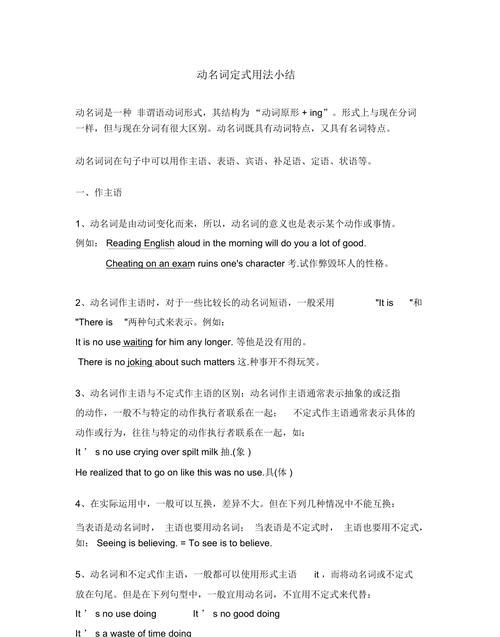本文目录
动名词作状语的例子
状语从句 (一)时间状语从句 表示时间的状语从句可由when, as, while, whenever, after, before, till (until), since, once, as soon as (或the moment ), by the time, no sooner … than, hardly (scarcely) … when, every time等引导。 e.g. When I came into the office, the teachers were having a meeting. He started as soon as he received the news. Once you see him, you will never forget him. No sooner had I gone to bed than I went to sleep. (二)原因状语从句 原因状语从句是表示原因或理由的,引导这类从句的最常用的连词是because, since, as , now that(既然)等,for 表示因果关系时(它引导的不是从句)为并列连词,语气不如because强。 e.g. He is disappointed because he didn't get the position. As it is raining, I will not go out. Now that you mention it, I do remember. (三)地点状语从句 引导地点状语从句的连词是where 和wherever等。 e.g. Sit wherever you like. Make a mark where you have a question. (四)目的状语从句 引导目的状语从句最常用的词(组)是so, so that(从句谓语常有情态动词), in order that, in case(以防,以免)等。 e.g. Speak clearly, so that they may understand you. She has bought the book in order that she could follow the TV lessons. He left early in case he should miss the train. (五)结果状语从句 结果状语从句是表示事态结果的从句,通常主句是原因,从句是结果。由so that (从句谓语一般没有情态动词), so … that, such … that等引导。 e.g. She was ill, so that she didn't attend the meeting. He was so excited that he could not say a word. She is such a good teacher that everyone admires her. (六)条件状语从句 条件状语从句分真实性(有可能实现的事情)与非真实性(条件与事实相反或者在说话者看来不大可能实现的事情)条件句。引导条件状语从句的词(组)主要有if, unless, so (as) long as, on condition that, so (as) far as, if only ( = if )。注意:条件从句中的if 不能用whether替换。 e.g. If he is not in the office, he must be out for lunch. You may borrow the book so long as you keep it clean. So far as I know(据我所知), he will be away for three months. &nb

英语中的动名词短语是啥 举例子
可以啊
,如引导
原因状语从句
的某个短语词组
considering
that(顾及到),seeing
that(由于)e.g:Seeing(that)quite
a
few
people
were
absent,we
decided
to
put
themeeting
off.(由于好些人都没有到会,我们决定延迟开会)

英语中的动名词短语是啥 举例子
不可以.动名词是不能够作状语的.
记得采纳啊

动名词作状语的用法
英语状语
英语中,修饰动词、形容词、副词等的句子成分叫状语(adverbial)。
状语的功用:状语说明地点、时间、原因、目的、结果、条件、方向、程度、方式和伴随状况等。
状语一般由副词、介词短语、分词和分词短语、不定式或相当于副词的词或短语来担当。其位置一般放在句末,但也可放在句首或句中。
副词是一种用来修饰动词,形容词,副词或全句的词,说明时间,地点,程度,方式等概念。
1.副词一般在句子中做状语.
He speaks English very well. 他英语说得非常好.
He is playing under the tree.中的under the tree(地点状语)
2. 不定式在句子中可以作目的状语。
I come specially to see you.我专门来看你.
3.介词短语
My parents often tell us about their bitter life in the past.
Ten years ago, She began to live in Dalian.
The boy was praised for his bravery.
4.从句作状语
When she was 12 years old, she began to live in Dalian.
If I am not busy tomorrow, I will play football with you.
5.分词作状语
Having had a quarrel with his wife, he left home in a bad temper。
Inhibited in one direction, it now seems that the Mississippi is about to take another.
============================================================
(一)什么是状语
状语是谓语里的另一个附加成分,它附加在谓语中心语的前面,从情状,时间,处所,方式,条件,对象,肯定,否定,范围和程度等方面对谓语中心进行修饰或限制.
状语与定语相同的地方是,都是前加附加成分;不同的地方是,它是谓语里的附加成分,而定语是主语或宾语里的附加成分.从句子的层次上看,状语是在第二个层次和第三个层次里的成分,有时甚至是更低层次的成分.
(二)状语的构成
经常充当状语的有形容词,副词,时间处所名词,能愿动词,指示代词,以及方位短语,介词短语,动宾短语,谓词性联合短语,谓词性偏正短语,谓词性主谓短语等.
含有动量词的数量短语以及重叠式的数量短语(不论动量,物量)也可以充当状语.
此外,少数名词带上表比况的助词也可以作状语.
(三)状语的书面标志——"地"
状语的书面标志是结构助词"地".状语后面带或者是不带"地",情况比较复杂.一般讲来,数量短语,主谓短语,动宾短语等作状语时,大都带"地";而介词短语,方位短语,能愿动词,时间处所名词作状语时不能带"地",副词,单音节形容词作状语一般也不带"地".
(四)多层状语
如果一个中心语前面有好几个状语(多层状语),那就应当注意它们的语序.多层状语的状语个数一般比多层定语的定语个数要少些,其语序也比多层定语的语序要灵活一些.
多层状语的一般语序:
1.表时间的名词或方位短语,介词短语;
2.副词.
3.表处所的介词短语或名词,方位短语;
4.表情态的形容词或谓词短语;
5.表对象的介词短语.
其中副词的位置较为灵活,也可放置在第三项之后.
(五)一般状语和句首状语
状语在句子中有两种位置:一种是在主语之后,谓语中心之前,如上文所举各例,这是状语的一般位置;另一种是放在主语的前面的,这是状语的特殊位置,这种状语可称"句首状语".
(二)主谓句
主谓句是由主语,谓语两个部分构成的单句,又叫双部句.在句子结构的第一个层次上就主谓双全是它的特点.
根据谓语的构成,或者说,根据充当谓语的词或短语的词性或语法功能类别,可将主谓句分成动词谓语句,形容词谓语句,名词谓语句三种.
1,动词谓语句:谓语由动词或动词性短语充当的主谓句.
2,形容词谓语句:由形容词或形容词性短语充当谓语的主谓句.
3,名词谓语句:由名词或名词性短语充当谓语的句子.
7

以上就是关于动名词作原因状语 ,动名词作状语的例子的全部内容,以及动名词作原因状语 的相关内容,希望能够帮到您。

